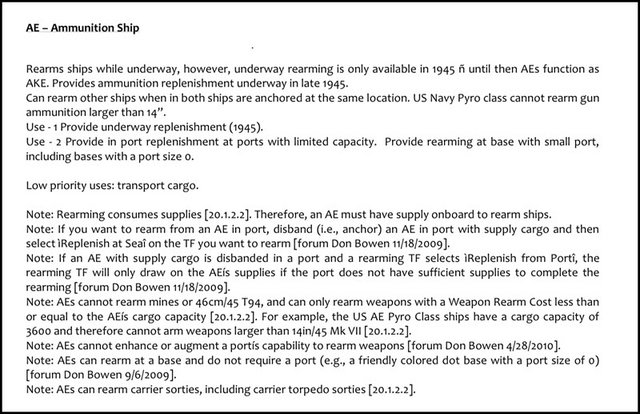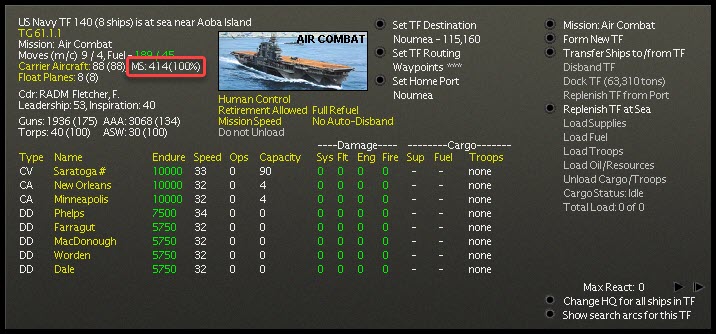Re: WITP-AE-Hilo oficial de Dudas
Publicado: 25 Ene 2021, 19:37
He consultado "The Forum Squeeze" y no hace distinción de bandos con la penalización del año 1945 en los AE.


http://www.puntadelanza.net/Foro/phpBB3/
http://www.puntadelanza.net/Foro/phpBB3/viewtopic.php?t=9514

Buenas noches, revisando la partida veo que remunicionó en el hexágono donde se encuentra el atolón de Adak Island, el puerto es de nivel 2, imagino que estando fondeados se pudo realizar el reabastecimiento de munición si no, no sé como lo hice...Akeno escribió: ↑25 Ene 2021, 19:32
Pensaba que el aliado podría antes y era el japonés el penalizado. Sí que está complicada la cosa, entonces mejor apostar siempre por un AK de grandes dimensiones y transformarlo en AKE para utilizarlo en bases avanzadas, porque en el 45 el japonés ya suele estar medio KO en muchos aspectos (iba a escribir grogui, pero no sé si esta palabra se entiende en latinoamérica).
De todas formas ha comentado Hollywood algo de que un AE sí que había reaprovisionado de munición a una TF en el mar, aunque no sé el año ni el bando que juega, supongo que aliado.
Gracias por la info.

Acafon escribió: ↑12 Feb 2021, 20:38
No entiendo muy bien el concepto de sorties, y con la lectura del manual tampoco me queda muy claro

Entiendo que el numero de la izquierda es el máximo de salidas que puedo realizar, ¿Pero que quiere decir eso? ¿Por qué tengo el número de la derecha en 0? ¿Eso es que no salen mis aviones?
Por otra parte me sale lo mismo en torpedos 36/0...0 en remaining.
Saludos

https://www.history.navy.mil/content/hi ... e-sea.htmlAkeno escribió: ↑25 Ene 2021, 19:32
Pensaba que el aliado podría antes y era el japonés el penalizado. Sí que está complicada la cosa, entonces mejor apostar siempre por un AK de grandes dimensiones y transformarlo en AKE para utilizarlo en bases avanzadas, porque en el 45 el japonés ya suele estar medio KO en muchos aspectos (iba a escribir grogui, pero no sé si esta palabra se entiende en latinoamérica).
De todas formas ha comentado Hollywood algo de que un AE sí que había reaprovisionado de munición a una TF en el mar, aunque no sé el año ni el bando que juega, supongo que aliado.
Gracias por la info.
New Methods in World War II
Despite the effort put into developing a fleet capability to execute the drive across the Pacific called for in War Plan Orange, the first major large-scale assault conducted acrossan ocean without a forward operating base occurred in the European theater—Operation Torch, the invasion of North Africa. More than 100 ships were refueled by five oil tankers and four Sangamon-class escort carriers that were converted Cimarron-class oilers.
In the meantime, during the initial months of the war, oilers in the Pacific Ocean were supporting raids on Japanese targets as well as operations in the Coral Sea and at Midway. November 1943’s Operation Galvanic, the capture of the Gilbert Islands, would build on that to keep the entire fleet of 200 ships continuously in the combat area by refueling at sea. During early 1945, TF-58 would steam continuously more than 7,500 nm over nearly two months while consuming 117 million gallons of fuel oil and 7 million gallons of aviation gas. As impressive as these feats were, the next major revolution at sea was about to accomplish even more.
In late 1944, Admiral Raymond Spruance had begun preparing to bomb the Japanese Home Islands to eliminate the air threat to the planned invasions of Iwo Jima and Okinawa. He realized that the primary hurdle to keeping his 12 aircraft carriers and associated escorts on station would not be fuel but rather ammunition. It would take only three days for the ships to expend their ordnance, after which they would have to make a 2,000-nm, 12-day sail to Ulithi Atoll and back—meaning only six days of bombing could occur per month. Admiral Spruance directed the development of a method for transferring ordnance and stores at sea, ultimately approving the Burton Method (named for the development team’s leader, Captain Burton Biggs), an adaptation of the pier-side process that used existing cargo winches on both thedelivery ship and aircraft carrier. On 23 February 1945, the USS Shasta (AE-6) conducted the first underway ammunition replenishment, by breaking ammunition out on deck by hand—including rolling bombs across the deck—and then levering it to the USS Bennington (CV-20).
Just a few weeks later, TF-58 sailed to support the upcoming invasions with an ammunition ship embedded among several oilers. Each time the task force expended all its ordnance, it would sail through the night to the rendezvous, then line up along a 40-nm front to make three successive replenishments and breakaways (fuel, then ammunition, then food/stores), before steaming overnight to the next objective. Instead of a three- to four-day engagement followed by a 10- to 12-day interlude, the task force was away for two nights for each three-day engagement. From March to June, TF-58 received 15,398 bags of mail, expended 16,373 tons of bombs, and consumed 2,219 tons of refrigerated foods, 4,005 tons of dry goods, and almost 426 million gallons offuel oil and 26 million gallons of aviation gas—more petroleum than Japan was able to produce or import for the entire year of 1944. This would be repeated when the Fifth Fleet became the Third Fleet, allowing Admiral William F. “Bull” Halsey Jr. and Vice Admiral John S. McCain to conduct ten major attacks on Japan, supported by nine replenishment events between 10 July and 10 August.

SilverDragon escribió: ↑12 Feb 2021, 22:29
A partir de finales del 44 lo que es suministro de municiones, comida y equipamiento. Combustible desde la primera guerra mundial.